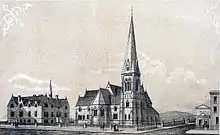Molyneux Asylum
The Molyneux Asylum for Blind Females was opened June 1, 1815 in Peter Street, Dublin, in what was formerly the residence of Thomas Molyneux (1641-1733), whose sister-in-law, Lucy Domville, had been blind. There was an Anglican church (Christ Church) attached to the asylum.[1] Music was an important part of the school and worship in the chapel.[2] R.W. Beaty was an organist and music instructor from 1824. Henry Charles Shellard was organist and choirmaster from 1901 to 1955.[3] The chapel was called the Albert Chapel, honoring the Queen's Husband.[4]
| The Molyneux Asylum for Blind Females | |
|---|---|
 Molyneux Church and Asylum, Leeson Park, 1860 | |
| Location | |
Peter St., later Leeson Park | |
| Information | |
| School type | Asylum for blind females |
| Religious affiliation(s) | Church of Ireland (Anglican) |
| Opened | 1815 |
| Closed | 2012 |
It was an exclusively Protestant institution, with all pupils educated in the principles of the Church of England.[5]
A new home for the asylum, along with a church, was constructed between 1860–1862 at Leeson Park. The architect, selected after a competition, was James Rawsom Carroll.[6] The adjoining Christ Church Chapel was consecrated in 1868.[3]
The first chaplain was Rev. John Crosthwaite MA another early chaplains to the asylum was Rev. Piers Edmund Butler.[7] Later came Rev. Dr. Charles Marley Fleury, in Peter St. and continuing with the move to Leeson Park. Rev. William R. Smith, a Rev. Arthur Thomas was a resident chaplain. Chaplain in the mid-19th century was Rev. James Metge, of Carlow. John Duncan Craig was chaplain from 1873 to 1884.[8] Rev. E. Marks and Rev. J.C.Lloyd served as Chaplains. The future Bishop Albert Hughes was a chaplain in the 1920s and 1930s.
Over the years the term Molineux House and Molyneux Institute for Blind Females, began to be used, dropping the outdated word Asylum in the name.
The building became a nursing home, with accommodation for 25 clients. The last client left in 2012, and the leeson park building was sold in 2015 for over 3million euro.[9] The Leeson Park Building and Chapel, are Listed Buildings. The Molyneux Home mission continues in partnership with St John's House, St Mary's Home and under the umbrella of the Protestant Aid, with the development of a new Nursing home at St. John's Merrion Rd.[10]
After the move to Leeson Park, The Molyneux House on Peter Street and Bride Street, was used as a hospital and then a Night Shelter by the Salvation Army, its Chapel was still used by the Church up until the 1920s. In 1943 it was developed by Jacob's Biscuit factory, some of the Chapel walls are incorporated into newer buildings.[11]
Molyneux Asylum Chapel (Christ Church)
Consecrated in 1868 the church was an episcopal church managed and funded by the patrons of the Asylum. It received the dedication of Christ Church in 1873. It became the functioning parish church for the area. As the area grew a chapel of ease St. Columbas (the tin church) was founded. In 1961 Christ Church became a separate entity from the Asylum. In 1963 due to a decline in numbers St. Columba's was closed. In 1972 the Methodist Congregation from St. Stephens Green, began to share the church for worship.[3] In 2006 The Methodist Centenary Congregation developed Wesley House on Leeson Park site. Also in 1972 the church was joined with St Bartholomew's Church, Dublin in a cluster of churches sharing clergy. The Church of Ireland ceased to worship as a parish church in 2005. From June 2005 the church was used to hold services for the Romanian Orthodox Community, with Fr. Godfrey O'Donnell and Fr. Calin Florea based there.[12] There is still a mid-week Eucharist celebrated by the Anglican community in the chapel, and it is also used occasionally by the Methodist Church, the President of the Methodist Church Peter Murray was installed at the church in 2014.[13]
References
- Library Ireland
- ' Selection of Psalms and Hymns, used at the Chapel of the Molyneux Asylum for Blind Females', printed by P. D. Hardy, 1833.
- Tent or Temple? - Archbishop Neill's address at the thanksgiving service to mark the end of Sunday Church of Ireland worship at Leeson Park www.ireland.anglican.org
- 'The Molyneux Family' by A. M. Fraser, Dublin Historical Record, Vol. 16, No. 1 (May, 1960), pp. 9-15 (7 pages) Published by: Old Dublin Society.
- 'Selection of Reports and Papers of the House of Commons: Irish poor', Volume 48.
- The Irish Times, 3 Jan 1881, p. 3
- Molyneux Home International Molyneux Family Association.
- Stephen Brown (ed) Ireland in Fiction. Maunsel, Dublin, 1919. p. 71
- Listed period nursing home sells for more than €3m By Justin Comiskey, Irish Times, February 4, 2015.
- Don’t Forget Your Shovel – Sod Turned on New Nursing Home Development United Dioceses of Dublin & Glendalough, dublin.anglican.org, April 22, 2016.
- Making A House A Home For All Sorts by Frank Hopkins, The Herald, February 3, 2009.
- Orthodox Christians of all shades now have a significant presence in Ireland by Patsy McGarry, Irish Times, May 14, 2008.
- Ecumenical history made in Dublin by Patsy McGarry, Irish Times, Jun 14 2014.